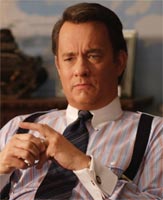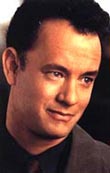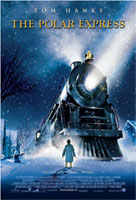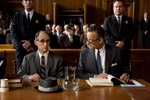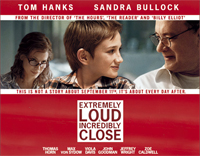Tom Hanks Inferno
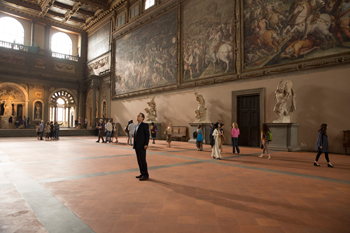
Tom Hanks Inferno
Cast: Tom Hanks, Felicity Jones, Irrfan Khan
Director: Ron Howard
Genre: Action, Adventure, Crime
Rated: M
Running Time: 121 minutes
Synopsis: Academy Award® winner Ron Howard returns to direct the latest bestseller in Dan Brown's (The Da Vinci Code) billion-dollar Robert Langdon series, Inferno, which finds the famous symbologist (again played by Tom Hanks) on a trail of clues tied to the great Dante himself. When Langdon wakes up in an Italian hospital with amnesia, he teams up with Sienna Brooks (Felicity Jones), a doctor he hopes will help him recover his memories. Together, they race across Europe and against the clock to stop a madman from unleashing a global virus that would wipe out half of the world's population.
Inferno
Release Date: October 13th, 2016
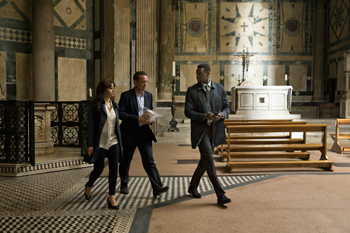 About The Production
About The Production
Following up on the worldwide successes of The Da Vinci Code (2006) and Angels & Demons (2009) is Inferno, the third highly anticipated adaptation in Dan Brown's Robert Langdon series of novels. Inferno, the latest addition in the $1.2 billion film franchise, was the best-selling adult book of 2013, proving that readers around the world can't get enough of Robert Langdon.
The film re-teams director Ron Howard, who most recently directed the acclaimed Beatles documentary Eight Days a Week: The Touring Years, with Tom Hanks, who returns in one of his signature roles playing the quick-thinking and resourceful Langdon. Tom Hanks explains the enduring attraction of the franchise. 'There is something Dan Brown has figured out – everybody likes a good puzzle, especially one you can actually figure out the clues to one at a time and solve," he says.
'These movies give that to the audience – it is almost an interactive film, and it has been like that since The Da Vinci Code."
Borrowing its title from Dante's masterwork, the Latin word for Hell, Inferno has the added component of a psychological thriller. In the film, Dr. Robert Langdon wakes up to face his biggest challenge yet – he has lost his memory. Haunted by feverish visions and intense headaches, he must find out what has happened to him, and why.
Tom Hanks explains, 'Hell for Langdon in the movie is both a state of mind and a very physical experience because he is wracked with pain in his head and he is tortured by the fact he is ignorant of the reasons why."
'Without a doubt, Robert Langdon goes through his own personal hell at the opening of this movie," says Dan Brown. "He wakes up in a hospital room in possession of a mysterious artifact for which people are trying to kill him. He must decipher the artifact and follow a trail of clues to find out who wants him dead and why. At the end of the day, he realises the stakes are far greater than his own personal drama – the future of the planet is at stake."
Inferno is the most visually stylistic film in the series so far, with a series of cryptic dream sequences that take audiences inside Langdon's head and lend an entirely different feel than previous installments. That is precisely what draws director Ron Howard to this series – out of 23 feature films made over more than three decades as a director, the only sequels he has chosen to helm are Angels & Demons and now Inferno. 'There have been characters that I love as much as I love Robert Langdon, but I always want to push myself to do something different. It's more interesting than repeating yourself," Ron Howard explains. 'But that's what's so great about the movies based on Dan Brown's books – each of them is so different, and he explores such different themes in each adventure. Inferno is the most stylistically different yet. With this series, I get to go back and revisit a character I love while continuing to push myself in new directions."
In the film, Langdon must make sense of clues relating to Dante's epic poem. Ron Howard explains, 'Langdon's hallucinating mind is tormented by a man obsessed with Dante. He's forced to pick up the pieces and make sense of this clue path that's been laid before him."
'Dante invented our modern conception of Hell," says producer Brian Grazer. 'In the book, Dante witnesses sinners on Earth punished by poetic justice. That becomes the basis of the puzzles Langdon has to solve in this movie. Dante described Hell; the painter Boticelli visualized Hell; but only Robert Langdon, the symbologist, can prevent Hell on Earth by stopping the release of a deadly virus."
One of the reasons Dan Brown's books strike a chord is his genius at translating the real mysteries of history into pulse-pounding thrillers for modern audiences. In Inferno, the underlying source for Brown's inspiration is Dante's Inferno. Dante, the great Italian poet of the 14th century, sought to describe the journey of the soul toward God, with the first step being the rejection of sin. In the epic poem, Dante himself is led through nine circles of Hell, where he sees unrepentant sinners punished by poetic justice: fortune tellers have their heads on backwards, unable to see what lies ahead; corrupt politicians with 'sticky fingers" are submerged in boiling tar. The greatest punishments are reserved for Dante's greatest villains, all traitors: in Satan's three mouths, to be chewed throughout eternity, are Cassius and Brutus, who murdered Julius Caesar, and Judas Iscariot.
For Dan Brown, the challenge was to take a work of genius that has inspired readers and artists for 800 years and find the elements that would springboard him into a Robert Langdon thriller. The answer came as Brown imagined what a modern idea of Hell would be, coming up with two concepts that fit neatly together: on the one hand, an overpopulated world, in which billions of people are unable to find sustenance, and on the other, a disease that takes out half the world's population. And for this Hell on Earth, Dan Brown borrows Dante's idea of poetic justice: in order to punish mankind for overpopulating the world beyond the planet's means, a villain will release a deadly disease that will kill billions.
'I wanted to create a villain who is deeply troubled by the issue of overpopulation on earth and decides to fix the problem himself," says Dan Brown. 'I'd read Dante as a kid, both in high school and college, but in order to write this novel, I had to re-read it many times in order to figure out how to create a palatable thriller out of a thirteenth century epic poem."
Of course, Tom Hanks returns as the Harvard symbologist. Ron Howard says the role fits the man like a glove. 'Part of the reason everybody loves Tom Hanks in this role is that, in real life, he is Robert Langdon," says Ron Howard. 'Both are driven by curiosity, share a dry sense of humor, and are men who, when faced with a puzzle, are like a dog with a bone – they are fascinated by the world around them and have the wonderful kind of mind that is able to decode it. And that's all on top of the fact that he's one of the best actors of our generation."
Tom Hanks enjoys returning time and again to the role of Robert Langdon because there's nothing quite like unraveling a riddle. 'Dan Brown created a character that can always be called into play: there's always going to be a mystery worth analysing," he says. 'These movies are fun and you learn something."
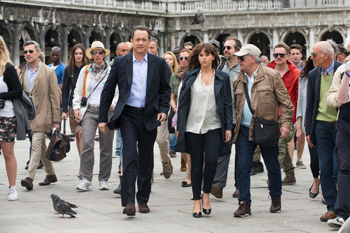 Once again, the international setting of the tale Dan Brown has spun offered the filmmakers a chance to surround Tom Hanks with a cast of global actors: the British Felicity Jones as Sienna Brooks; the French actor Omar Sy as Christoph Bouchard; Indian star Irrfan Khan as Harry Sims; and Danish actress Sidse Babett Knudsen as Dr. Elizabeth Sinskey. Ben Foster, an American, also stars, as the bioengineer Bertrand Zobrist. 'One of the thrilling aspects of a Dan Brown story is that the international setting truly offers the opportunity to cast the best person for the role, regardless of their nationality," says Brian Grazer. 'It's important and necessary, because one of the ways Ron is telling the story of Langdon's global adventure is in surrounding him with a cast that looks and sounds like the entire world."
Once again, the international setting of the tale Dan Brown has spun offered the filmmakers a chance to surround Tom Hanks with a cast of global actors: the British Felicity Jones as Sienna Brooks; the French actor Omar Sy as Christoph Bouchard; Indian star Irrfan Khan as Harry Sims; and Danish actress Sidse Babett Knudsen as Dr. Elizabeth Sinskey. Ben Foster, an American, also stars, as the bioengineer Bertrand Zobrist. 'One of the thrilling aspects of a Dan Brown story is that the international setting truly offers the opportunity to cast the best person for the role, regardless of their nationality," says Brian Grazer. 'It's important and necessary, because one of the ways Ron is telling the story of Langdon's global adventure is in surrounding him with a cast that looks and sounds like the entire world." Just as he did in The Da Vinci Code and Angels & Demons, Dan Brown touches on topics in Inferno that are highly relevant to today's world. In Brown's novels and in the films, Tom Hanks points out, 'There is always some degree of a question." In Inferno, the questions revolve around overpopulation. 'Are there really too many people being born? Is there a way we may be able to solve our overpopulation? Or will our world become a new version of Dante's Inferno?"
Like its predecessors, Inferno is also a truly worldwide adventure. 'That is one of the great bonuses of being in one of these movies," says Tom Hanks. 'We have always gone to fascinating places, real places. On Inferno, we were actually on the roof of Basilica of San Marco in Venice and that is production value par excellence!"
'It's always great when you're making any movie when you can be in the actual locations," says Ron Howard. 'Set construction is great, CGI is fantastic, but there's nothing like when you're actually in the place, and the way it influences everybody involved in front of and behind the camera."
In typical Dan Brown fashion, the audience is right there with Langdon as he unravels each mystery, creating an unforgettable experience that audiences have come to expect from these films. 'Inferno has every reason to be exciting to audiences, because it has drama, it has action, it's a thriller, it has a human dimension," explains Brian Grazer. 'It has all these sort of thriller components, a very big international cast, you travel throughout the world in a very kind of exotic and in some ways almost a fantasy way and it's driven by Langdon played by Tom Hanks."
Ben Foster puts the experience into perspective. 'I really love this series of films," says Ben Foster. 'You learn something, there are great characters, you get to travel around the world and they keep you on the edge of your seat. It is good, fun moviemaking."
About The Cast
Shooting in locations all around the world also allows for a truly diverse cast and crew. 'What's so spectacular about doing these Dan Brown/Robert Langdon thrillers is that you get to create, in an organic way, a reason for an international cast to exist," explains producer Brian Grazer.
At the center of the film, of course, is Tom Hanks as Robert Langdon. He says that Inferno marks a major point of departure for the character. 'He usually knows everything there is to know about symbols, art, history, architecture, politics, and geopolitical cultures. But when the movie starts, he has no idea where he is or why," says Tom Hanks. 'He goes to Venice, Florence and Istanbul – places he is supposed to know backwards and forwards, but he doesn't. The mystery starts immediately – how did he get amnesia? Why is he here?"
Opposite Hanks is the Academy Award® nominated actress Felicity Jones, who stars as Dr. Sienna Brooks. For Felicity Jones, there is more to her character than meets the eye. 'Sienna Brooks is a young woman who is a strong environmentalist, full of conviction," says Felicity Jones. 'Sienna Brooks is not everything she seems but on the surface she is someone that gets involved in a mystery relating to finding a deadly virus."
That is one of the aspects that drew Felicity Jones to the role, she says: 'This is really a contemporary story about paranoia, fear of governments, and who we can trust."
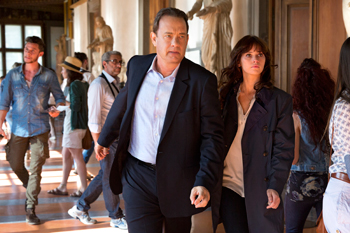 For inspiration in playing her character, Felicity Jones says she went straight to the source material. 'When I knew I had the part of Sienna, I read Dan Brown's book – it was a really fun read," she recalls.
For inspiration in playing her character, Felicity Jones says she went straight to the source material. 'When I knew I had the part of Sienna, I read Dan Brown's book – it was a really fun read," she recalls. 'Throughout filming, I would keep coming back to the book for Sienna and find little clues about her backstory that I could use in playing her. The book was a really good resource throughout filming."
French actor Omar Sy, who plays the character of Christoph Bouchard, talks about the international cast and crew gathered for Inferno. 'There are English, American, Italian, Hungarian, French, Indian, Danish and Swiss - all these people from around the world working towards the same goal, moving in the same direction and giving all their energy to the same project," says Omar Sy. 'It is a very good feeling and I'm proud to be a part of it."
For Omar Sy, Inferno marked a welcome chance to play a role in dramatic opposition to a screen persona that is well-known in France, but not as famous in the US. 'I have a background in comedy – I'm always smiling," he explains, 'but in this movie, Ron Howard gave me the chance to play a tough guy, and I feel very lucky. It's always been my dream to play this kind of a role. Actually, it was not difficult – I just cut out the smile!"
Ben Foster plays the complex Bertrand Zobrist, who is the main force behind setting the plot into motion. 'The character I'm playing is a bioengineer, a provocateur I suppose, who is discussing the deadly realities of overpopulation," Ben Foster explains. 'He is determined to create a virus and release it in protection of the Earth's best interests."
'The first thing Ron Howard said to me was that he didn't want people leaving the theater thinking my character was either the bad guy or the good guy," Ben Foster continues. 'It was important to him that people are left with a question."
Part of what makes Zobrist a fascinating target is that though his methods are insane, he lays out a methodical and (almost) convincing case for their necessity. 'The dialogue was very tricky, because it was important to Ron and to David Koepp, the screenwriter, that all of our statistics were correct," Foster says. 'We are dealing with real facts, organized to make a compelling argument. Animals, farms, forests, and land have been cultivated to help an ecosystem survive. When you start looking at the human animal, those questions become personal and frightening very quickly."
Indian superstar Irrfan Khan plays Harry Sims, Provost of the Command Risk Consortium. 'Initially, Sims runs the consortium that is looking after Zobrist's interests," says Khan. 'Zobrist is a client of the Consortium but the World Health Organization has an idea that he is trying to develop a virus that can reduce the world's population by half so they are keen to question him. My mission in the film becomes to stop Zobrist's dream from becoming reality."
Though the film shot in so many dramatic, real-world locations, Khan says that the location that best reflects his character is one that was built on a soundstage: Sims' office on the Consortium ship. 'I love the way they created my office – it is so high-tech, precise and cool," he says. 'Everything is meticulous, and that is how the Provost is; he is doing a very dangerous, secretive job, and that is what the set reflects."
Danish actress Sidse Babett Knudsen plays Dr. Elizabeth Sinskey, the leader of the World Health Organization who works to prevent the spread of the deadly virus. 'She is chasing this virus with a very limited amount of time before it breaks out and kills us all," she says. 'She also shares a past with Robert Langdon."
Best-known among US bingewatchers for her leading role in the Danish television series 'Borgen," Knudsen says she was drawn to the role by the fact that her character is something of an enigma initially. 'I like that, for quite a while, Elizabeth Sinskey is a mystery woman," says Sidse Babett Knudsen. We do not know what her agenda is but she has a double agenda, just like every other character in the film. So we played around with that and had fun with it."
Inferno also marked a first for Sidse Babett Knudsen: she had never done stunt work before. 'I did some underwater stuff on the cistern set," she notes. 'I had to go down into the water, secure a bag, and place it into a cube containment case. It was actually a difficult procedure, because I couldn't see that well under the water. It was exciting – I didn't know I could hold my breath for that long."
The film keeps the line between who's good and who's bad up to interpretation, leaving the audience guessing. Explains Omar Sy, 'The difference between this film and the previous two is that this is a chase and the clock is ticking, which keeps up the pace. Also there is a philosophical question abo
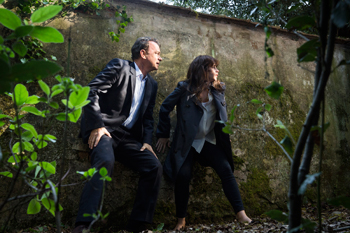 ut our existence on this planet that is very interesting. I wonder what side the audience will take."
ut our existence on this planet that is very interesting. I wonder what side the audience will take." About The Locations
Beautiful and historically significant locations form the backdrop to the mystery thriller Inferno. A huge 70% of the film was shot on location in the cities of Venice, Florence, Budapest, and Istanbul.
Venice
Filming kicked off in the spectacular St Mark's Square as Langdon and Sienna follow the clues to Doge's Palace.
St. Mark's Square or Piazza San Marco is the symbolic heart of Venice; it has been referred to as the drawing room of Europe. With the grand St. Mark's Church at one end, the Campanile bell tower rising in the middle and the elegant colonnaded arcade of famous cafes on three sides. The Doge's Palace, situated on the water front of the square, is a Venetian gothic style building. As the name suggests, it was the resident of the Doge of Venice, the supreme authority of the former Republic of Venice. The palace was opened as a museum in 1923.
Florence
The chase sequence through Florence takes Langdon and Sienna through the grand gardens of the Palazzo Pitti, leading to their escape route through a secret doorway in Boboli Gardens. The doorway leads to the Vasari Corridor, which runs entire length of the Ponte Vecchio and into the Uffzi Gallery. Having failed to capture their target, Sinskey and Bouchard reconvene in the Palazzo Courtyard.
The Palazzo Pitti is a huge palace dating back to 15th Century. It was most famously owned by the Grand Duke Cosimo I de' Medici, and was the family's official residence.
Rising behind the Palazzo are the majestic Boboli Gardens. They were originally designed for the Medici and are one of the earliest examples of the Italian Garden which later inspired those of many European courts. The gardens extend over a vast area forming an open-air museum with antique and Renaissance statues, grottoes and large fountains. Unique to Florence is the Ponte Vecchio (Old Bridge). It's most striking feature is the multitude of shops built on its edges, held up by stilts. The bridge also carries Vasari's elevated corridor linking the Palazzo Pitti to the Uffizi Museum, one of the finest art galleries of the world. First constructed by the Etruscans in ancient times, this bridge is the only one in the city to have survived World War II intact.
Continuing along the path of clues, Langdon and Sienna find themselves in the magnificent Hall of 500 at the Palazzo Vecchio.
The Palazzo Vecchio is the town hall of Florence and one of the most significant public places in Italy. Although most of Palazzo Vecchio is now a museum, it remains the symbol of local government. Since 1872 it has housed the office of the Mayor of Florence and it is the seat of the City Council. The Inferno production filmed for four days here to capture scenes of Langdon tracing his steps through the events that lead to his situation. The crew utilized several spaces at Palazzo Vecchio including the Hall of 500, the Hall of Geographical Maps or Wardrobe, and the First Courtyard.
Langdon and Sienna then follow the trail left by Zobrist to the Baptistery in Florence, also known as the Baptistery of St. John.
The Baptistery is situated in the Piazza del Duomo. Not only is the Baptistery one of the oldest buildings in the city (construction began in 1059), it is also one of Florence's most important religious buildings. Renowned for its remarkable bronze doors, the 'doors of paradise," Dante and many other notable Renaissance figures were baptized here, as were all Catholic Florentines until the end of the nineteenth century.
It is an octagonal building, covered on the outside with white and green marble. On the inside, the dome is entirely covered with mosaic showing the Angelic Hierarchies, scenes from Genesis, the life of Joseph the Patriarch, the life of Jesus Christ, the life of St. John the Baptist and the Last Judgment.
Budapest
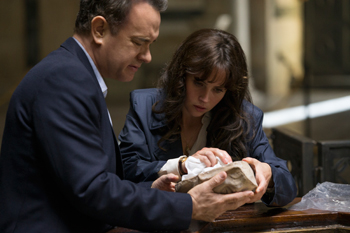
Several scenes were filmed in Budapest, including much of the film's stage work. Out on location, the city's European feel was able to double for the locations in much of the rest of the film. For example, the scene in which Langdon and Sienna discover the disappearance of the Dante death mask in Palazzo Vecchio was actually filmed at the Ethnographical Museum in Budapest.
This is also where the incriminating CCTV footage is played back to Langdon and Sienna's shock. The Museum of Ethnography in Budapest is one of Europe's largest, most important museums. Its diverse collections house more than 200,000 ethnographic artifacts, as well as historical photographs, manuscripts, folk music recordings, films, and videos of both Hungarian and international cultural interest.
Scenes in which Langdon and Sienna are chased through St Mark's Basilica subterranean chapel in Venice were filmed in the basement of the remarkable Kiscelli Museum in Budapest.
Situated on the hillside in Buda, the Kiscelli Museum is the ensemble of a former baroque monastery and church. Over the decades, the building was also used as military barracks and hospital before it was purchased in 1910 by the Vienna-based art collector and furniture manufacturer Max Schmidt, who turned it into a luxurious mansion. In Schmidt's last will, he left the property and land to the people of Buda on the provision that it become a park and museum open to the public. Despite being badly damaged in World War II, the property still stands and serves as a spectacular museum and art gallery.
The terrifying and grotesque scenes that play in Langdon's visions were shot in a picturesque street to the side of the Hungarian State Opera House.
The Hungarian State Opera House was designed by Miklos Ybl, a major figure of 19th century Hungarian architecture, and was first opened to the public in 1884.
Built in neo-Renaissance style, with elements of Baroque, ornamentation includes paintings and sculptures by leading figures of Hungarian art. In terms of beauty and the quality of acoustics, the Budapest Opera House is considered to be amongst the finest opera houses in the world.
The Hungarian National Museum served as Harvard University for the scenes in which Langdon struggles to recover his memory.
The Hungarian National Museum (Magyar Nemzeti Múzeum) is the oldest public museum in Hungary. The present building was constructed between 1837 and 1847, and it stands as a great example of Neo-Classicist architecture. Founded 200 years ago, the museum is dedicated to the history of Hungary and today it remains a symbol of Hungary's national identity.
Istanbul
A small crew followed to the mystical city of Istanbul, Turkey, for a weekend to shoot scenes of Langdon, Sinskey and Sims' arrival at the breathtaking Hagia Sofia.
The Hagia Sofia was once a church, then a mosque and is now a museum. Built by the order of the Eastern Roman emperor Justinian at the 6th century AD, it is the only building in the world that served to three religions; Pagan, Christian Orthodox and Sunni Islam. There are large cisterns under the building which are described by historians as big enough for a boat to fit in. These cisterns were replicated by the Inferno art department for filming the climax of the movie on the studio lot in Budapest.
About The Design
Although many of the scenes set in Venice, Florence, and Istanbul were shot in those cities, some scenes were shot in Budapest, doubling for those cities. Very often, a single location within the film would actually be shot over different locations in different cities, and it was the job of production designer Peter Wenham to make those transitions seamless.
To make one city look like another, Wenham oversaw the transformation. There are obvious examples of his handiwork, like transforming the signage and license plates on cars from Hungarian into Italian – and less obvious examples. 'The street lighting was very important," he says. 'In Florence, the lamps have extended iron arms that extend from the walls, and little lancets that are dominant. We fit shutters to the exterior of buildings – anyone who's been to Florence has seen that. It was very important to give that illusion."
 Another illusion was Wenham's transformation of Budapest's Ethnographical Museum into the Italian space that houses Dante's death mask. Although filming in the real space was impossible, Wenham notes that an imagined space suited the story better anyway: 'In the real place, the actual mask is in a wooden cabinet with a bit of red silk behind it," he says.
Another illusion was Wenham's transformation of Budapest's Ethnographical Museum into the Italian space that houses Dante's death mask. Although filming in the real space was impossible, Wenham notes that an imagined space suited the story better anyway: 'In the real place, the actual mask is in a wooden cabinet with a bit of red silk behind it," he says. With free rein to imagine a more cinematic space, Wenham's imagination was let loose at the Budapest museum. 'The spaces themselves – the widths of the corridors, the transitional pieces into different areas – felt just right." What wasn't right was the neoclassical architecture of the city. 'There's a lot of variety of architecture in Budapest, but if there's one thing it isn't, it's Italian." To make the space work, Wenham's department gave the museum a costume of sorts. 'We went to considerable lengths with foaming, cladding, and latexing existing marble – we painted over that, and removed it afterwards. It was like putting on a new skin."
Budapest also proved to be a match for Venice, as Wenham recreated the crypts below San Marco. 'Practically speaking, the action lends itself to either a set or a location not so precious at the Basilica itself," he says. 'We were able to shoot on the balcony, but the transition through the church is a combination of some set pieces that we'd built on stage mixed with some plate work. We found a museum in Budapest that worked – it was a very dusty, crumbly old place, and we put in a new floor that we replicated photographically from the real crypt floor. Then we put in the railings and built an altar for the religious artifacts."
Other locations were built on sets in Budapest: for example, Wenham's team created the subterranean cistern set below the Hagia Sophia. To suit the story, the water in the set is a bit deeper than it is in real life, and Wenham's set is, by his estimation, about one-fifth the size of the real place; with blue screen on two sides, the VFX team added to Wenham's set to make it look even larger.
Wenham was also intricately involved in the design of the Hell Street sequences – cryptic dream sequences in which the visions of Dante's Hell come to life in Langdon's mind. 'It's a bizarre environment we created," he says. 'We're not in Europe. We're not in America. We wanted it too look like a normal street with normal people, until you look at it a bit more closely and see that it's very odd. The cars are all black. We blended the signage with the tonality of the buildings themselves. The road workers in the middle of the road are using pikes, like those in Botticelli's map of hell. All of these subtleties are peppered into a seemingly normal, contemporary landscape that gets more and more bizarre as Langdon's mind gets deeper and deeper into his confusion."
Fun Facts
Zobrist's deadly virus, Inferno, was made by the prop department with the following recipe: 40% water, 30% vegetable oil and 30% tomato ketchup.
Ron Howard enlisted the help of philosopher and futurist Jason Silva to help build the harrowing YouTube video Zobrist produces to support his idea that over population will lead to human extinction.
The prop department made a total of 15 Dante Death Masks for the film, ensuring they would never be caught without one.
Whilst filming in Florence, the production made a donation to the Palazzo Vecchio for the restoration of home of Dante's death mask.
When Vayentha falls from the ceiling in the Hall of 500, in order to protect the ancient flooring, the SFX department manufactured a fake pool of blood made out of red silicone.
Langdon and Sienna were dressed in Ferragamo.
Whilst in Florence, Ron Howard was honored by the mayor and presented with the Keys to the City. In ancient times, when it was common for European towns to be ringed by walls, visiting dignitaries were presented with a key to the city gate as a gesture of trust and kindness. Today's gesture of presenting keys is similar in sentiment if not in function.
For the drone scene chasing Langdon and Sienna through Boboli Gardens, the camera team had to deploy two drones; one to follow the actors and the other to film the action.
Ana Ularu had never driven a motorbike before taking the part of Vayentha... now she is hooked and is looking forward to getting her license!
For filming Langdon's visions of hell, the special effects department purchased 9,000 liters of fake, sugar-based blood.
Inferno
Release Date: October 13th, 2016
Have You Seen This?
MORE
- Mission: Impossible Fallout
- Glenn Close The Wife
- Allison Chhorn Stanley's Mouth Interview
- Benicio Del Toro Sicario: Day of the Soldado
- Dame Judi Dench Tea With The Dames
- Sandra Bullock Ocean's 8
- Chris Pratt Jurassic World: Fallen Kingdom
- Claudia Sangiorgi Dalimore and Michelle Grace...
- Rachel McAdams Disobedience Interview
- Sebastián Lelio and Alessandro Nivola...
- Perri Cummings Trench Interview

